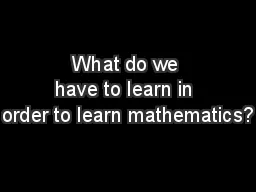

Anne Watson Stirling 2009 What good maths students do grasp formal structure think logically in spatial numerical and symbolic relationships generalise rapidly and broadly curtail mental processes ID: 461717
Download Presentation The PPT/PDF document "What do we have to learn in order to lea..." is the property of its rightful owner. Permission is granted to download and print the materials on this web site for personal, non-commercial use only, and to display it on your personal computer provided you do not modify the materials and that you retain all copyright notices contained in the materials. By downloading content from our website, you accept the terms of this agreement.
Slide1
What do we have to learn in order to learn mathematics?
Anne Watson
Stirling 2009Slide2
What good maths students do
grasp formal structure
think logically in spatial, numerical and symbolic relationships
generalise rapidly and broadly
curtail mental processes
be flexible with mental processes
appreciate clarity and rationality
switch from direct to reverse trains of thought
memorise mathematical objectsSlide3
English interactive teachingSlide4
What good maths students do
grasp formal structure
think logically in spatial, numerical and symbolic relationships
generalise rapidly and broadly
curtail mental processes
be flexible with mental processes
appreciate clarity and rationality
switch from direct to reverse trains of thought
memorise mathematical objectsSlide5
Working mathematically (Aus)
‘
Higher achievement was associated with:
asking ‘what if..?’ questions
giving explanations
testing
conjectures
checking answers for reasonableness
splitting problems into subproblems
Not associated with:
explicit teaching of problem-solving strategies
making
conjectures
sharing strategies
Negatively associated with use of real life contextsSlide6
Why?
What activities cannot change students’ ways of thinking or objects of attention?
What activities require new ways of thinking?Slide7
What new ways of thinking are necessary in mathematics?Slide8
49 + 35 – 35Slide9
From number to structure
From calculation to relationSlide10
What good maths students do
grasp formal structure
think logically
in spatial,
numerical
and symbolic relationships
generalise rapidly and broadly
curtail mental processes
be flexible with mental processes
appreciate clarity and rationality
switch from direct to reverse trains of thought
memorise
mathematical objectsSlide11
Find the number mid-way between
28 and 34
280 and 340
2.8 and 3.4
.00028 and .00034
1028 and 1034
38 and 44
-38 and -44
40 and 46Slide12
From physical to models
From symbols to images
From models to rules
From rules to tools
From answering questions to seeking similaritiesSlide13
What good maths students do
grasp formal structure
think logically in spatial, numerical and symbolic relationships
generalise rapidly and broadly
curtail mental processes
be flexible with mental processes
appreciate clarity and rationality
switch from direct to reverse trains of thought
memorise mathematical objectsSlide14Slide15Slide16
From visual response to thinking about properties
From ‘it looks like…’ to ‘it must be…’Slide17
What good maths students do
grasp formal structure
think logically in spatial, numerical and symbolic relationships
generalise rapidly and broadly
curtail mental processes
be flexible with mental processes
appreciate clarity and rationality
switch from direct to reverse trains of thought
memorise mathematical objectsSlide18
What nearly all learners can do naturally
Describe
Draw on prior experience and repertoire
Informal induction
Visualise
Seek pattern
Compare, classify
Explore variation
Informal deduction
Create objects with one or more features
Exemplify
Express in ‘own words’
Slide19
What teachers do
Make or elicit statements
Ask learners to do things
Direct attention and suggest ways of seeing
Ask for learners to respondSlide20
What else do mathematics teachers do?
Discuss implications
Integrate and connect
Affirm
This is where shifts can be made, talked about, embeddedSlide21
Discuss implications
Vary the variables, adapt procedures, identify relationships, explain and justify, induction and prediction, deductionSlide22
What are the mathematical implications of …?Slide23
Integrate and connect
Associate ideas, generalise, abstract, objectify, formalise, defineSlide24
What is mathematically important about …?Slide25
Affirm
Adapt/ transform ideas, apply to more complex maths and to other contexts, prove, evaluate the processSlide26
How do we know this mathematics works … ?Slide27
Mathematical habits of mind to be developed
Pattern seeking
Experimenting
Describing
Tinkering
Inventing
Visualising
Conjecturing
GuessingSlide28
Special algebraic habits
Like algorithms
See calculations as structures of operations
Represent classes of mathematical objects and their relations
Extend meaning over new domains
AbstractionSlide29
ab = c
c/a = b
c/b = aSlide30
Special geometric habits
Like shapes
Proportional reasoning
Explore systems and distinctions
Worry about change and invariance
Reason about propertiesSlide31Slide32
Changes in habits of mind for mathematics
between generalities and examples
between making change and thinking about mechanisms of change
between different points of view and representations
between induction and deduction
using domains of meaning
and
extreme valuesSlide33
Summary
doing and undoing
rules and tools
exemplify/generalise
representing/transforming
discrete and continuous
mathematical reasoning
relating objects and relating propertiesSlide34
anne.watson@education.ox.ac.uk
www.cmtp.co.uk
9
th
Annual Institute of Mathematics Pedagogy
July 28
th
to 31
st
Cuddesdon near Oxford
s.elliott@shu.ac.uk
John Mason, Malcolm Swan, Anne Watson
Raising Achievement in Secondary Mathematics
Watson (Open University Press)
Pocket PAL: Building Learning in Mathematics
Prestage, DeGeest and Watson (Continuum)
Mathematics as a Constructive Activity
Watson & Mason (Erlbaum)